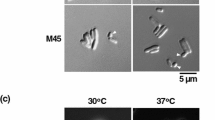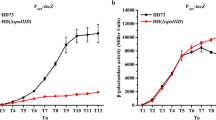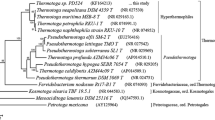Summary
Bacillus thuringiensis var.kurstaki (HD-1)_was grown as a continuous phased culture in a cyclone fermentor. During the time course of the continuous phased cultivation (CPC), the culture was sampled to determine the efficiency of sporulation and parasporal crystal formation. Concurrently, plasmid DNA was extracted and resolved on agarose gels. The plasmid profile remained constant throughout 328 h of cultivation. However, during the same time period, asporogenous, acrystalliferous variants increased from<1% to>90% of the cells harvested. Our data suggests that the disappearance of parasporal crystals inB. thuringiensis var.kurstaki (HD-1) during CPC occurs independent of plasmid copy but may be due to defective sporulation.
Similar content being viewed by others
References
Birnboim, H.C., and Doly, J.C. (1979). A rapid alkaline extraction procedure for screening recombinant plasmid DNA. Nucl. Acids. Res. 7, 1513–1523.
Blokhina, T.P., Sakharova, Z.V., Ignatenko, Yu. N., Rabotnava, I.L., and Rautenshtein, Ya.I. (1984). Variability inBacillus thuringiensis under various growth conditions. Microbiol. 53:340–344 Translation of Mikrobiologiya 53, 427–431.
Boudreaux, D.P., and Srinivasan, V.R. (1981). A continuous culture study of growth ofBacillus cereus T. J. Gen. Microbiol. 122, 129–135.
Couch, T.L., and Ross, D.A. (1980). Production and utilization ofBacillus thuringiensis Biotechnol. and Bioeng. 22, 1297–1304.
Dawson, P.S.S. (1965). Continuous phased growth, with a modified chemostat. Can J.Microbiol. 11, 893–903.
Godwin, D., and Slater, J.H. (1979). The influence of the growth environment on the stability of a drug resistance plasmid inE. coli K12. J. Gen. Microbiol. 111, 201–210.
Gonzalez, J.M., Jr., Dulmage, H. T., and Carlton, B.C. (1981). Correlation between specific plasmids and delta-endotoxin production inBacillus thuringiensis. Plasmid 5, 351–365.
Held, G.A., Bulla, L.A. Jr., Farrari, E., Hoch, J., Aronson, A.I., and Minnich, S.A. (1982). Cloning and localization of the lepidopteran protoxin gene ofBacillus thuringiensis subsp.kurstaki. Proc. Natl. Acad. Sci. USA 79, 6065–6069.
Imanaka, T., Tsunekawa, H., and Aiba, S. (1980). Phenotypic stability oftrp operon recombinants plasmids inEscherichia coli. J. Gen. Microbiol. 118, 253–261.
Kamdar, H., and Jayaraman, K. (1983). Spontaneous loss of a high molecular weight plasmid and the biocide ofBacillus thuringiensis var.israeliensis. Biochem. Biophys. Res. Comm. 110, 477–482.
Khachatourians, G.G. (1986). Production and use of biological pest control agents. Trends in Biotechnol. 4, 120–124.
Kronstad, J.W., Schnepf, H.E., and Whiteley, H.R. (1983). Diversity of locations forBacillus thuringiensis crystal protein genes. J. Bacteriol. 154, 419–428.
Lereclus, D., Lecadet, M., Ribier, J., and Dedonder, R. (1982). Molecular relationships among plasmids ofBacillus thuringiensis; Conserved sequences through 11 crystalliferous strains. Mol. Gen. Genet. 186, 391–398.
Melling, J., Ellwood, D.C., and Robinson, A. (1977). Survival of R-factor carryingEscherichia coli in mixed cultures in the chemostat. FEMS Microbiol. Lett. 2, 87–89
Miwa, K., Nakamori, S., Sano, K. and Momose, H. (1984). Stability of recombinant plasmids carrying the threonine operon inEscherichia coli. Agric. Biol. Chem. 48, 2233–2237.
Nickerson, L.W., and Bulla, L. A., Jr., (1974). Physiology of sporeforming bacteria associated with insects: Minimal nutritional requirements for growth, sporulation and parasporal crystal formation ofBacillus thuringiensis. Appl. Microbiol. 28, 124–128.
Nilsson, J., and Skogman, S.G. (1986). Stabilization ofEscherichia coli tryptophan production vectors in continuous cultures: A comparison of three different systems. Bio/Technol. 4, 901–903.
Noack, D., Roth, M. Geuther, R., Muller, G. Undisz, K., Hoffmeier, C., and Gaspar, S. (1981). Maintenance and genetic stability of vector plasmids pBR322 and pBR325 inEscherichia coli K12 strains grown in a chemostat. Mol. Gen Genet. 184, 121–124.
Nugent, M.E., Primrose, S.B., and Tacon, W.C.A. (1983) The stability of recombinant DNA. in: Developments in Industrial Microbiology. C.H. Nash and L.A. Underkofler eds. vol. 24, pp. 271–285, Arlington, Virginia: Society for Industrial Microbiology.
Rood, J.I., Sneddon, M.K., and Morrison, J.F. (1980) Instability intyr R strains of plasmids carrying the tyrosine operon: Isolation and characterization of plasmid derivatives with insertions or deletions. J. Bacteriol. 144, 552–559.
Rosteck, P.R., Jr., and Hershberger, C.L. (1983). Selective retention of recombinant plasmids coding for human insulin. Gene 25, 29–38.
Schnepf, H.E., and Whiteley, H.R. (1981). Cloning and expression of theBacillus thuringiensis crystal protein gene inEscherichia coli. Proc. Natl. Acad. Sci. USA 78, 2893–2897.
Selinger, L.B., Dawson, P.S.S, and Khachatourians, G.G. (1987) Behavior ofBacillus thuringiensis var.kurstaki under batch and continuous phased cultivation in a cyclone fermentor. Submitted to Appl. Microbiol. Biotechnol.
Skogman, L.G., Nilsson, J., and Gustafsson, P. (1983). The use of a partition locus to increase stability of tryptophan-operon-bearing plasmids inEscherichia coli. Gene 23, 105–115.
Summers, D. K., and Sherratt, D.J. (1984). Multimerization of high copy number plasmids causes instability: Col E1 encodes a determinant essential for plasmid monomerization and stability. Cell 36, 1097–1103.
Tsunekawa, H., Tateishi, M., Imanaka, T., and Aiba, S. (1981). TnA-directed deletion of thetrp operon from RSF2124-trp inEscherichia coli. J. Gen. Microbiol. 127, 93–102.
Wouters, J.T.M., and van Andel, J.G. (1983). Persistance of the R6 plasmid inEscherichia coli grown in chemostat cultures. FEMS Microbiol. Lett. 16, 169–174.
Author information
Authors and Affiliations
Rights and permissions
About this article
Cite this article
Roy, B.P., Selinger, L.B. & Khachatourians, G.G. Plasmid stability ofBacillus thuringiensis var.kurstaki (HD-1) during continuous phased cultivation. Biotechnol Lett 9, 483–488 (1987). https://doi.org/10.1007/BF01027457
Issue Date:
DOI: https://doi.org/10.1007/BF01027457




